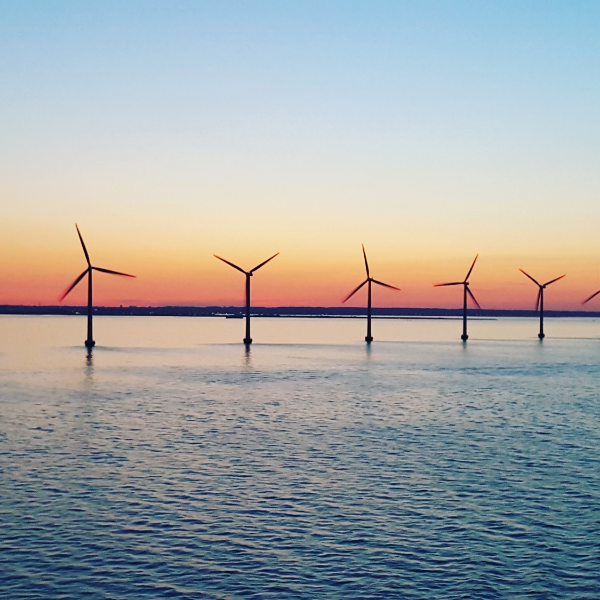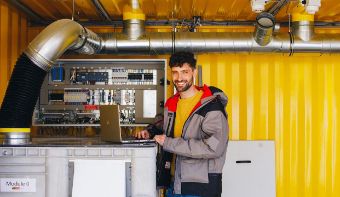Energy transition
Accelerating towards an integrated system

Energy transition
The transition from fossil-generated energy to energy from non-fossil sources is one of the major challenges we face as a society. Under the Climate Agreement, CO2 reduction targets are set by law. Our CO2 emissions need to be reduced drastically. How do we do this and how do we achieve the targets set?
The energy transition requires a different organisation of the energy chain, from generation to consumption. Witteveen+Bos, active throughout the energy chain, offers technical, economic and implementation advice to accelerate the transition to non-fossil energy sources. After all, time is running out!
Integrated system
One of the most important challenges is how we can combine new, sustainable energy solutions from production to distribution and use in a single system. As a multidisciplinary consultancy, Witteveen+Bos is ideally equipped to do just that. With our diverse expertise, we help clients throughout the value chain from generation, storage, distribution and advice to optimise energy consumption.
For instance, we work at the (supra)national level for the Dutch government (including the Ministry of Economic Affairs and Climate Policy), for which we wrote, among other things, an energy scenario study on nuclear energy, we are involved in the Programme Connection Wind At Sea (PAWOZ) and we collaborate on the construction of fast-charging infrastructure in the programme Stopcontact op Land. In early 2023, we signed a framework agreement with Gasunie to adapt existing infrastructure to non-fossil gases (including CO2, hydrogen).
Making the right choices and implementing solutions
At the regional/local level, we are involved in drawing up energy strategies for developers, municipalities, regional authorities and building owners. Among our assignments, we are working on Regional Energy Strategies (RES), heat networks and heating programmes for several regions.
At the district level, Witteveen+Bos contributes to the design of natural gas-free neighbourhoods, for example by identifying alternative energy sources. At business parks, we help several companies save energy, make their processes natural gas-free and share energy in energy hubs. We help to make the right choices and then to prepare and implement new energy systems, as well as in contracting.
In which fields are we active?
Electricity
Towards an affordable and stable energy supply
The goal of the Climate Agreement is a completely carbon-free electricity system by 2050, replacing existing fossil sources with non-fossil sources. It does not stop at the transition from fossil to renewable. Demand for renewable electricity is rising sharply due to extensive electrification in the mobility, agriculture, built environment and industrial sectors.
This entails challenges. How can we meet this energy demand and keep it affordable? Witteveen+Bos contributes to these challenges in various fields and at various levels.
We cover a considerable part of the electricity chain: from exploratory studies (e.g. for the Ministry of Economic Affairs and Climate Policy) and integration studies (e.g. for TenneT) to concrete designs for energy infrastructure (e.g. for regional grid operators, shore power, charging infrastructure).
This entails major challenges. How can we meet this energy demand and keep it affordable? Witteveen+Bos contributes to solving these challenges in various fields and at various levels.
Mobility
Charging infrastructure and smart mobility
Mobility currently accounts for 30 per cent of carbon emissions in the Netherlands. Electrifying the Netherlands’ vehicle fleet can significantly reduce this. Take, for example, the electrification of various modes of transport, such as passenger cars, public transport buses, freight and construction traffic, shipping and mobile equipment.
Crucial is the creation of (charging) infrastructure to meet this electricity demand and smart charging solutions with, for instance, batteries for tools and other equipment. To run all those electric vehicles, around 1.8 million charging stations need to be available in the Netherlands by 2030 in a variety of locations: at private homes, businesses, petrol stations or mobility hubs.
In the field of charging infrastructure, we advise municipalities and other stakeholders on switching to zero-emission public transport. We have also developed a tool to map the feasibility of e-buses in urban public transport areas or at a depot. Another study concerns the feasibility of integrating charging infrastructure into an existing system.
Built environment
Energy efficient and more sustainable
By 2050, 7 million homes and 1 million buildings in the Netherlands will have to be disconnected from natural gas. Other countries are facing similar challenges. This switch requires the incorporation of other energy sources and carriers such as electricity (heat pumps), storage (batteries) or the construction of district heating projects (waste heat, geothermal or aquifer thermal energy). There is also an energy-saving task by adequately insulating existing buildings.
Witteveen+Bos is active at various levels in this transition to natural gas-free neighbourhoods. This includes conducting feasibility and zoning studies for heat networks at the national and regional/local level. We also have experience in mapping the potential of thermal energy from waste and surface water (TES, TEW).
At the area and building level, we conduct feasibility studies and detailed engineering for public and private clients. Collective thinking to make neighbourhoods and buildings part of a system (e.g. heat networks) is central.
At the building level, we advise in building physics optimisations using the Trias Energetica approach. We focus on the building itself (e.g. insulation) and on designing climate-neutral systems based on renewable energy sources.
Industry
Towards climate-neutral production
Industry must be completely circular and emit practically no greenhouse gas by 2050. Industry will therefore increasingly need to switch to more sustainable energy sources that perform better than fossil fuels in terms of carbon emissions, availability and price. The question is how does a company change over to a substantially more sustainable and efficient energy system?
Witteveen+Bos helps industry make this transition. We carry out advanced analyses of the current energy system and advise industry throughout the process, from determining a sustainability strategy to a concept design of specific sustainability projects.
Once the optimal energy configuration for a business case has been determined, we can design the modifications according to the required specifications and the business-specific standards.
Integral approach to energy
One of the most important challenges in the worldwide energy transition is how we can combine new, sustainable energy solutions from production to distribution and use in one integrated system. With our expertise, we help our customers throughout the value chain from generation, storage, distribution and advice to optimise energy consumption.

GROHW - an initiative of Witteveen+Bos
We are increasingly encountering grid congestion; there is not enough space available on the electricity grid to accomodate the increase in locally generated sustainable energy. At the same time the demand for (sustainable) electricity increases. GROHW - Green Oxygen, Hydrogen and Wasteheat production - aims to accelerate the energy transition and reduce of CO2 emissions, with green hydrogen as the most important building block.

More information?

















